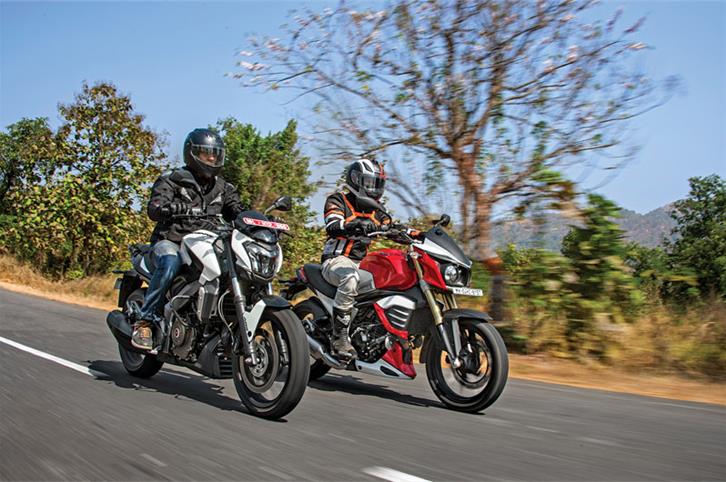Bajaj Dominar 400 vs Mojo vs Himalayan comparison
With touring on the menu, we delve into some highly debatable topics to find out which of these three bikes serves its purpose better, and which one is more deserving of your money.
Published on Feb 06, 2017 04:20:00 PM
44,629 Views
Follow us on



Dropping anchor
The Dominar really shines in the braking department. The 320mm disc at the front and the 230mm one at the rear do a phenomenal job of bringing the motorcycle to a complete halt. The front brake feels sharp and precise, while the rear feels more progressive. Coupled with the MRF Revz C1 tyres and twin-channel ABS, our Vbox figures revealed that the Dominar comes to a complete stop from 60kph in just 2.02sec and 17.20m.
The Himalayan’s brakes, however, tell a slightly different story. While it gets a slightly smaller front disc at 300mm and a slightly larger rear one at 240mm, it simply cannot keep up with the Dominar when it comes to stopping power. In contrast, the front brake feels more progressive, while the rear brake feels sharp; this may not be that great on the road. This setup actually works best off-road, and keeps the front from locking up, while the rear does, and that allows you to tighten up your turns and use it to steer.
The Mojo is shod with a 320mm disc at the front, made by Jijuan, a Spanish firm that works with Mahindra Racing, while the Dominar gets its brakes from Bybre. The front brake on the Mojo does lack initial bite, but is intended to be progressive; the bite does come in later. At the rear, the Mojo gets a 240mm disc, similar to the Himalayan. But the lack of weight over the rear tyre and a sharp bite means the rear does lock up quite easily.
The Dominar 400 and Mojo share the exactly the same tyre profile. The Dominar’s locally made MRF rubber provide excellent levels of grip, while the Mojo’s Pirelli Diablo Rosso II tyres, aside from being more expensive, provide even more traction. The Himalayan gets dual-purpose tyres from Ceat that provide reasonable levels of grip on the road and offit. Where the Mojo and Himalayan fall short is ABS, they don’t get any at this point. The Dominar gets a more expensive variant with ABS; twin-channel at that. And even this, more expensive, variant, still comes in cheaper than the other two bikes.
Power sailin’
While we know for a fact the Mojo’s engine is an absolute gem, the Dominar’s engine shares some base components with the KTM 390 series; we can all agree that the one on the KTM is definitely a bomber of an engine. The Dominar’s engine is a single overhead camshaft derivative of the 373cc KTM Duke and RC 390 engine. It has oversquare bore dimensions, and comes with Bajaj’s triple-spark technology, with its four valves nesting inside a compact single-cylinder head. And while this fuel-injected, liquid-cooled engine may produce less power than the KTM, it’s no slouch at all. It feels punchy and strong, and pulls in a very linear manner to its rev limiter, close to 10,000rpm. Gearshifts up and down the six-speed ‘box feed in with a precise, light feel. The bonus here is that the Dominar 400 also gets a slipper clutch which steps in to allow hard downshifting from high speeds. The gear ratios feel just right and perfectly matched to the engine’s long legs. In fact, overall, the Bajaj encourages you to ride it hard and this is where it feels in its element.
The Himalayan’s engine feels very relaxed in its power delivery. This 411cc single-cylinder unit, with undersquare dimensions, relies on a simple layout with a single overhead camshaft and two valves. It is fed via a carburettor with throttle position sensor, and produces 24.5hp that is driven towards the rear wheel through a five-speed gearbox. The gearbox, however, may feel a bit notchy when shifting at the wrong rpm, and that’s a hassle in city conditions. The tall gear ratios ensure a cruising agenda on the road. And when off-road, these rations mean you don’t have to shift gears too much. The Dominar 400 and Mojo get liquid-cooled, fuel-injected engines.
The Mahindra Mojo’s 295cc unit makes 27hp and 30Nm. So, the Dominar 400 does lead in terms of power output and torque figures, which was expected from the extra 78cc of displacement. But the Mojo’s engine is no pussycat. Once it hits the 4,500-5,000rpm mark, there is this surge of power and torque that makes this motorcycle feel a lot more powerful than just 27hp. It also gets a six-speed gearbox (minus the slipper clutch) which works quite well, except for some rather confusing ratios in the higher gears.
Copyright (c) Autocar India. All rights reserved.



Comments
Member Login
Personal Details
No comments yet. Be the first to comment.